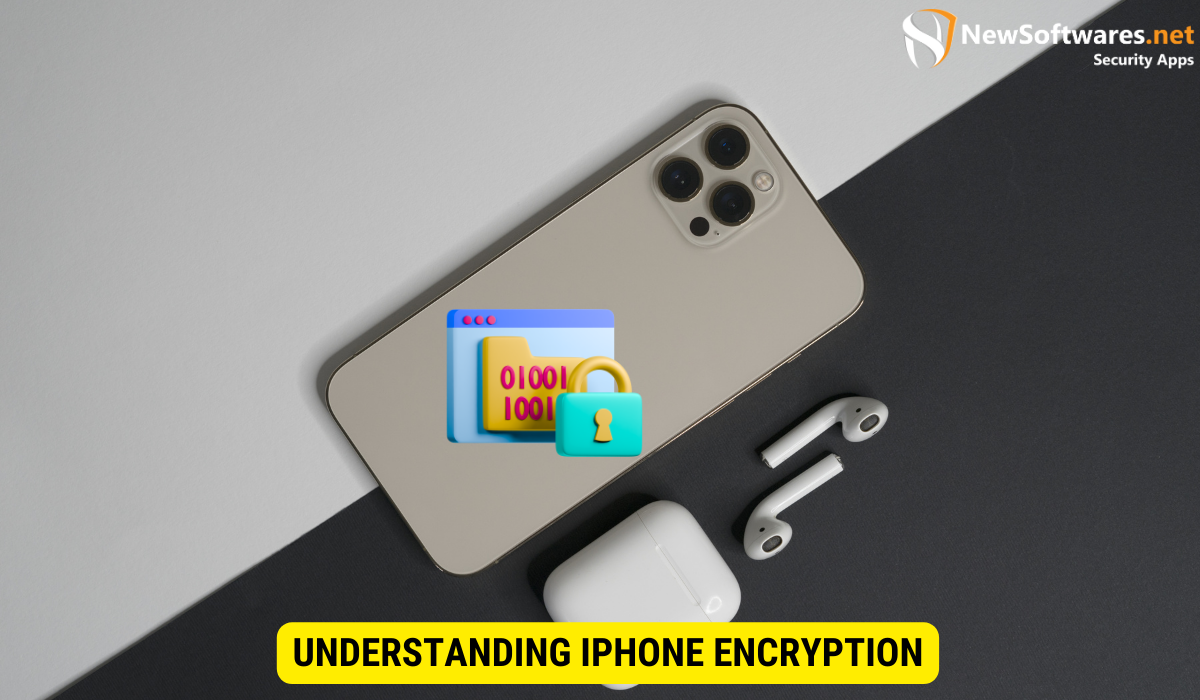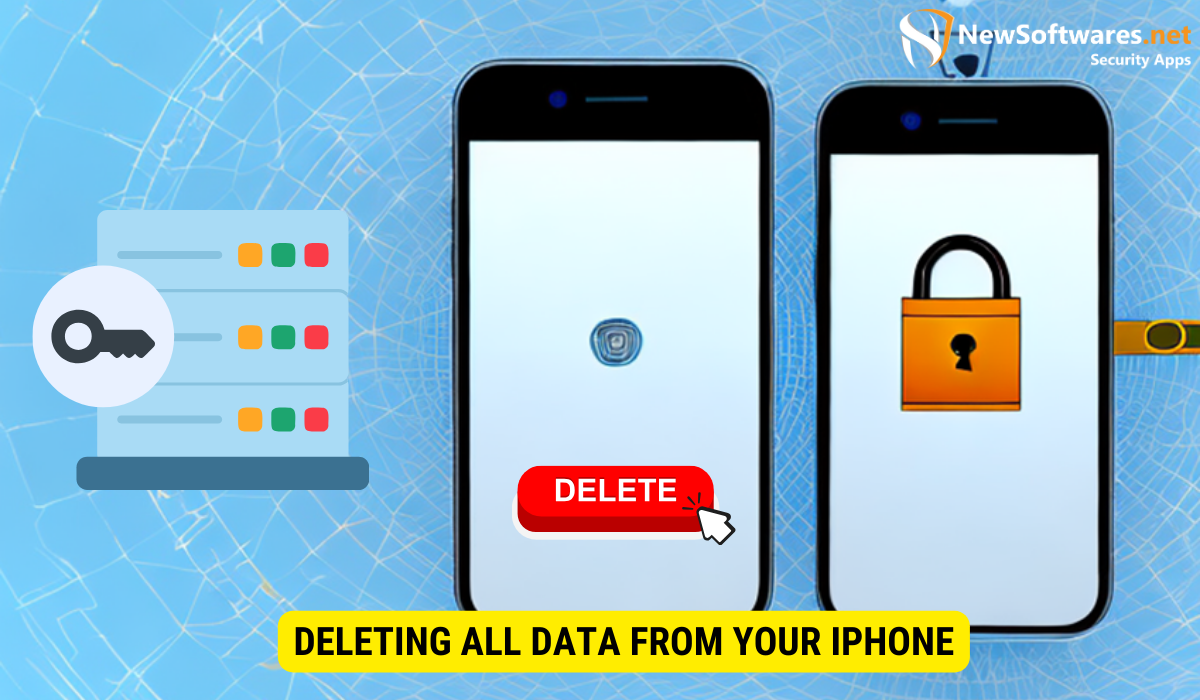To encrypt and lock your iPhone while securely deleting all data, follow these essential steps:
- Encrypt Your iPhone:
- Set a strong passcode in your iPhone’s settings, avoiding common and easily guessable combinations.
- Enable data protection by going to Settings, selecting Touch ID & Passcode (or Face ID & Passcode on newer models), and turning on the “Data Protection” option. This ensures that your data is only accessible with the correct passcode.
- Lock Your iPhone Securely:
- If your iPhone supports Touch ID, register your fingerprint as a biometric means of unlocking your device. Navigate to Settings, choose Touch ID & Passcode, and follow the on-screen instructions.
- For iPhones with Face ID, set up facial recognition by going to Settings, selecting Face ID & Passcode, and following the prompts to configure Face ID.
- Delete All Data from Your iPhone:
- Before wiping your device, back up your data using iCloud or iTunes to prevent accidental data loss.
- Sign out of all accounts and services, including iCloud, iTunes, and the App Store.
- Perform a factory reset by going to Settings, choosing General, scrolling down to Reset, and selecting “Erase All Content and Settings.” Note that this action is irreversible, so ensure you have backed up essential data.
- Additional Security Measures:
- Regularly update your iPhone’s software to stay protected against security vulnerabilities. Keep your device running the latest version of iOS.
- Enable two-factor authentication (2FA) on your accounts to add an extra layer of security, requiring a verification code in addition to your password for access.
By following these steps and implementing additional security measures, you can effectively encrypt, lock, and protect your iPhone, safeguarding your personal data and privacy in today’s digital landscape.
In today’s digital world, maintaining the security and privacy of our personal information is more important than ever. With the amount of sensitive data stored on our mobile devices, it becomes crucial to take necessary steps to protect our iPhones from unauthorized access. One effective way to achieve this is by encrypting and locking our iPhones. Together, we will explore the importance of iPhone encryption, the steps to encrypt your device, and how to lock your iPhone securely. We will also discuss the process of deleting all the data from your iPhone, along with additional security measures you can take to enhance the protection of your device.
Understanding iPhone Encryption

Your iPhone contains a wealth of personal and sensitive information, including contacts, messages, photos, and even financial data. The purpose of iPhone encryption is to convert this data into an unreadable format, known as ciphertext, making it nearly impossible for unauthorized individuals to gain access to your information. Encryption acts as a safeguard against data breaches, theft, and other security threats.
When it comes to protecting your personal information, iPhone encryption plays a vital role. It utilizes sophisticated algorithms to ensure that your data is securely stored and transmitted. By enabling encryption on your device, you create an additional layer of security, making it significantly harder for anyone to access your sensitive data.
What is iPhone Encryption?
iPhone encryption is a security feature that goes beyond just setting a passcode on your device. It involves a complex process of converting your data into an unreadable format using advanced cryptographic algorithms. This process ensures that even if someone manages to gain physical access to your iPhone, they won’t be able to read your personal data without the correct passcode.
When you enable encryption on your iPhone, the device generates a unique encryption key that is securely stored within the device’s hardware. This key is used to encrypt and decrypt your data, providing an additional layer of protection. Without the correct encryption key, the data on your iPhone remains locked and inaccessible.
Importance of Encrypting Your iPhone
Encrypting your iPhone offers several important benefits. Firstly, it protects your personal information from unauthorized access in case of theft or loss. Imagine the peace of mind you would have knowing that even if your iPhone falls into the wrong hands, your sensitive data remains secure and unreadable.
In addition to physical security, encryption also protects your data from potential hackers. With the increasing prevalence of cyber threats, it’s crucial to take every precaution to safeguard your personal information. By encrypting your iPhone, you make it significantly harder for hackers to extract data from your device, ensuring that your privacy remains intact.
Furthermore, encryption plays a crucial role in securing your data when using cloud services and transferring information over networks. When you sync your iPhone with cloud storage or transfer data wirelessly, encryption ensures that your sensitive information remains safe from prying eyes. It adds an extra layer of protection, ensuring that only authorized individuals can access your data.
Overall, iPhone encryption is a powerful security feature that helps protect your personal and sensitive information. By enabling encryption on your device, you can rest assured that your data remains secure, even in the face of potential threats and vulnerabilities.
Steps to Encrypt Your iPhone
Encrypting your iPhone is a straightforward process that can be done in a few simple steps:
Setting a Strong Passcode
The first step in encrypting your iPhone is to establish a strong passcode. This should be a unique combination of numbers, letters, and symbols that is not easily guessable. Avoid using commonly used passcodes like “123456” or your birthdate, as these can compromise the security of your device.
Turning on Data Protection
After setting a strong passcode, you can enable the data protection feature on your iPhone. Data protection uses your passcode as the encryption key, ensuring that your data is only accessible when the correct passcode is entered. To turn on data protection, go to Settings, select Touch ID & Passcode (or Face ID & Passcode on iPhone X and newer), and enable the “Data Protection” option.
Locking Your iPhone
Locking your iPhone provides an additional layer of security, preventing unauthorized users from accessing your device. There are two primary methods of locking your iPhone: using Touch ID and setting up Face ID.
Using Touch ID for Security
If your iPhone supports Touch ID, you can utilize your fingerprint as a means of unlocking your device. Touch ID is a highly secure biometric authentication method that ensures only your registered fingerprint can unlock your iPhone. To set up Touch ID, navigate to Settings, select Touch ID & Passcode (or Face ID & Passcode on iPhone X and newer), and follow the on-screen instructions to register your fingerprint.
Setting up Face ID
For iPhone models that feature Face ID, you can use facial recognition technology to lock and unlock your device. Face ID utilizes the TrueDepth camera system to create a detailed map of your face, making it highly secure and reliable. To set up Face ID, go to Settings, select Face ID & Passcode, and follow the prompts to set up your facial recognition.
Deleting All Data from Your iPhone

There may come a time when you need to delete all the data from your iPhone, such as when selling or giving away your device. It’s crucial to ensure that your personal information is completely erased to prevent any potential misuse or privacy breaches. Here is how you can securely delete all data from your iPhone:
Preparing Your iPhone for Data Deletion
Before wiping your device, it’s essential to create a backup of your data to avoid any accidental loss. You can back up your iPhone using iCloud or by connecting it to your computer and using iTunes. Once you have backed up your data, sign out of all your accounts and services, including iCloud, iTunes, and the App Store. This will help ensure that your personal data is disassociated from your device.
Performing a Factory Reset
To delete all data from your iPhone, perform a factory reset. This will restore your device to its original settings, erasing all personal information and apps. To perform a factory reset, go to Settings, select General, then scroll down and tap on Reset. Choose the “Erase All Content and Settings” option and follow the on-screen instructions to initiate the process. It is important to note that this action cannot be undone, so make sure you have backed up any necessary data beforehand.
Additional Security Measures
While encrypting and locking your iPhone are vital steps in protecting your device, there are additional security measures you can take to enhance your iPhone’s overall security:
Regularly Updating Your iPhone
Keeping your iPhone’s software up to date is crucial for security. Apple regularly releases software updates that include important security patches, bug fixes, and performance enhancements. By ensuring that your iPhone is running the latest version of iOS, you can stay protected against potential vulnerabilities.
Using Two-Factor Authentication
Enable two-factor authentication (2FA) on your iPhone to add an extra layer of security to your accounts. With 2FA enabled, you will need to provide a verification code, in addition to your password, when signing in to your accounts on new devices. This helps prevent unauthorized access even if your password is compromised.
Key Takeaways
- iPhone encryption is vital for protecting personal data against theft, breaches, and cyber threats.
- Encrypt your iPhone by setting a strong passcode and enabling data protection in device settings.
- Lock your iPhone securely with Touch ID or Face ID for enhanced protection.
- Securely delete all data from your iPhone by performing a factory reset after creating a backup.
- Additional security measures include regular software updates and enabling two-factor authentication.
FAQs
What is iPhone encryption, and why is it important?
iPhone encryption is a security feature that converts your data into unreadable format, enhancing protection against unauthorized access, theft, and data breaches.
How can I encrypt my iPhone?
Enable data protection by setting a strong passcode, using Touch ID or Face ID, and turning on data protection in your device’s settings.
How do I securely delete all data from my iPhone?
Create a backup, sign out of accounts, and perform a factory reset by going to Settings > General > Reset > Erase All Content and Settings.
Are there additional security measures for iPhone protection?
Yes, regularly update your iPhone’s software and enable two-factor authentication for added security against potential threats.
What are the benefits of iPhone encryption for data security?
iPhone encryption safeguards personal information, prevents unauthorized access, and protects data during cloud syncing and network transfers.
Conclusion
In today’s digital world, safeguarding your iPhone’s security and privacy is paramount. iPhone encryption, strong passcodes, and data deletion are essential steps to protect your sensitive data and enhance device security. By following these measures and staying vigilant about software updates and two-factor authentication, you can ensure the safety of your personal information on your iPhone.
